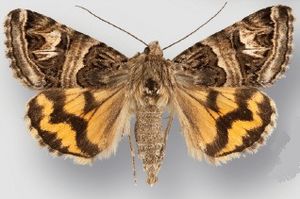Drasteria parallela facts for kids
Quick facts for kids Drasteria parallela |
|
|---|---|
 |
|
| Male | |
| Scientific classification | |
| Genus: |
Drasteria
|
| Species: |
parallela
|
Drasteria parallela is a type of moth that belongs to the Erebidae family. These moths are found in specific mountain areas of western North America. You can spot them in the Cascade Mountains of Washington, the Klamath and Siskiyou Mountains in south-western Oregon, and the northern Sierra Nevada in California. They prefer living on exposed ridges within forests at middle elevations.
What Does It Look Like?
Drasteria parallela moths are medium-sized. Their front wings, called forewings, are about 17 to 20 millimeters long for males. Females have slightly shorter forewings, around 18 millimeters.
The forewings have a mix of brown, tan, and gray colors.
- The part of the wing near the body is dark brown. It has patches of tan and lead-gray.
- The middle section of the wing is a lighter tan. It gets darker near the front edge.
- The outer part of the wing is whitish-gray to gray. Near the very edge, it can be blue-gray or brown-gray.
- There's often a dark gray or black spot at the tip of the wing.
The back wings, called hindwings, are a dull light yellow-orange to dull orange. They have a lot of gray scales near the body and along the inner edge.
These moths are usually seen flying in July.
What's in a Name?
The name Drasteria parallela gives us a clue about this moth's appearance. The word "parallela" refers to the parallel lines that cross the pale middle area of its forewing.
This name continues a pattern of using geometry terms for related moth species. For example, there are also Drasteria divergens and Drasteria convergens. These names suggest how lines on their wings might spread apart (diverge) or come together (converge).

